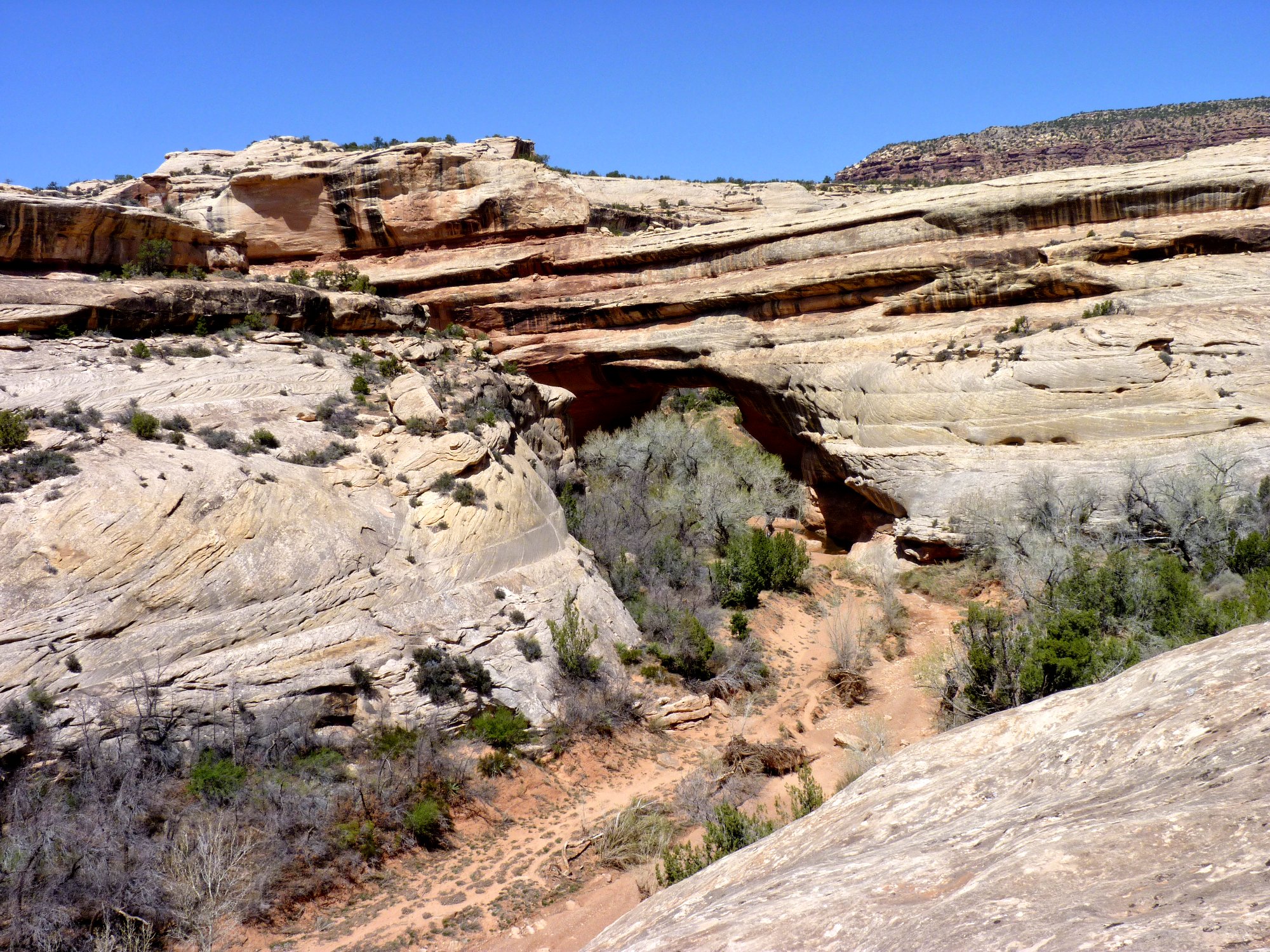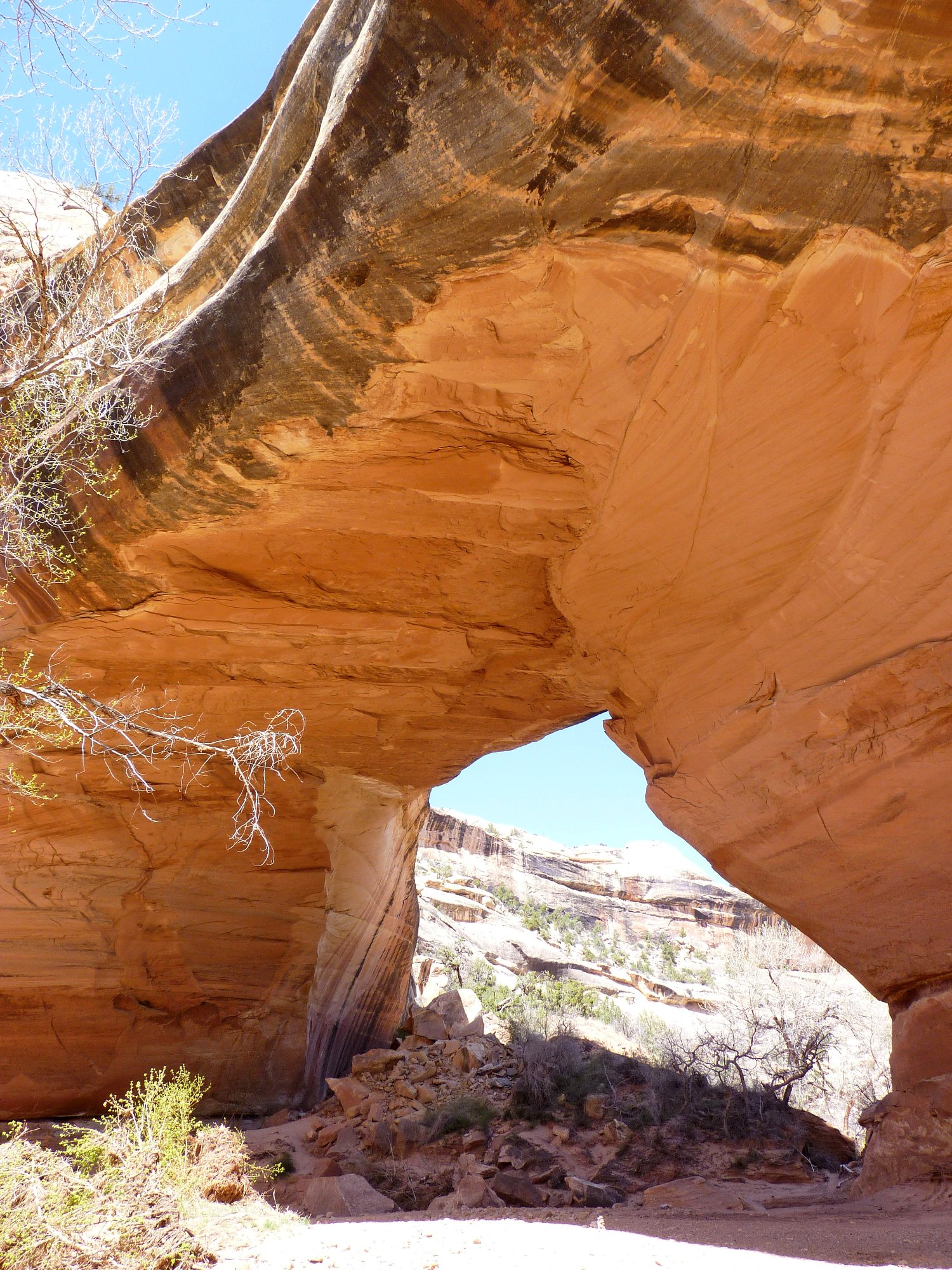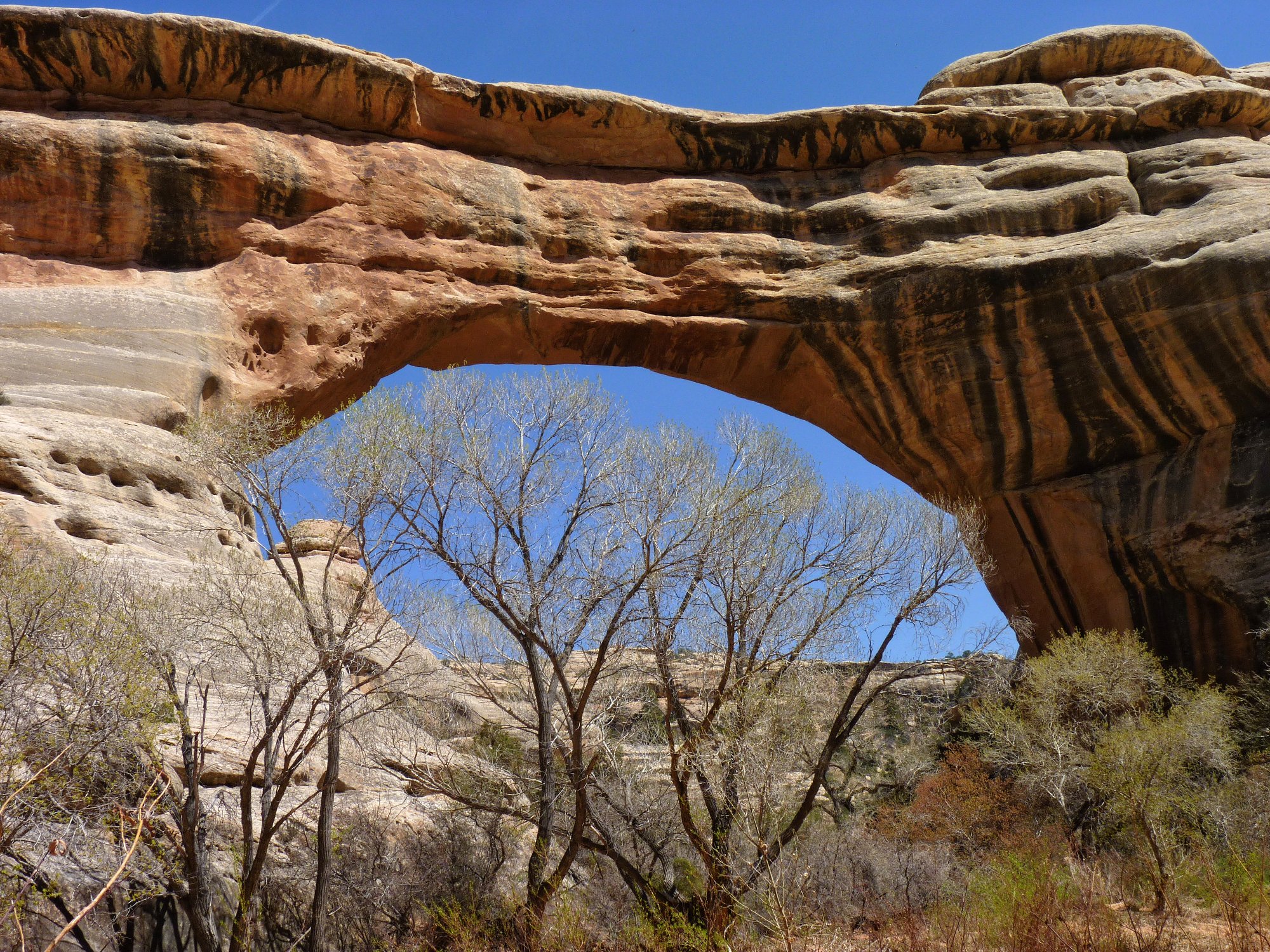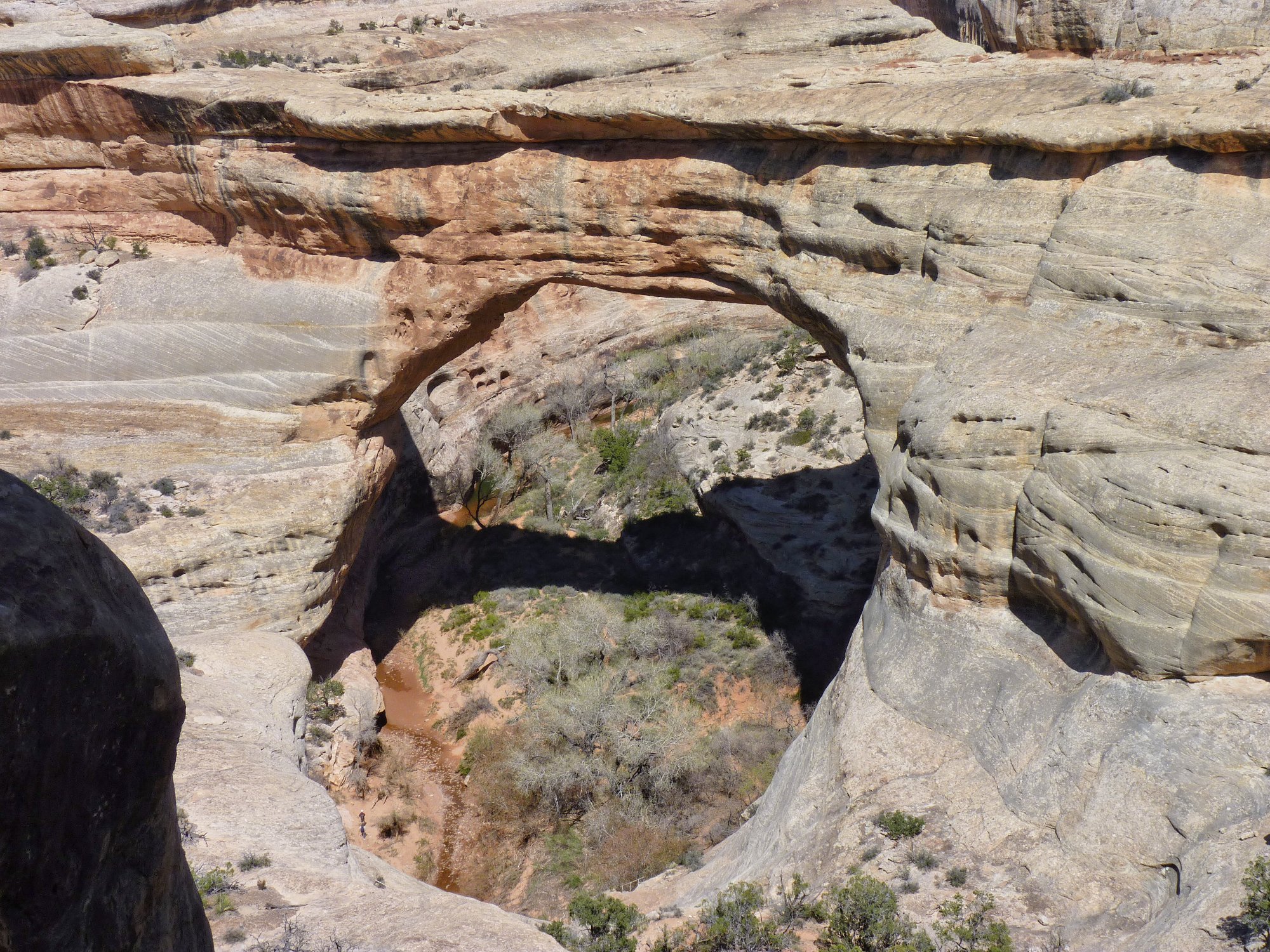
Natural Bridges National Monument
 |
Three Bridges Loop
Natural Bridges National Monument |
April 16, 2011
This area first became known to the public when National Geographic published
the article, Colossal Natural Bridges of Utah,
in 1904. Readers had trouble believing the story of three stone
bridges, clustered together, and far more massive than anything previously discovered
or even imagined. President Roosevelt created the national monument in 1908.
Overviews of two of the bridges are available from roadside lookouts, and
there are individual trails down to all three; but there is a better way to
see these magnificent formations — a loop trip that traverses
two washes and visits each of the bridges in turn.
The hike will be long enough as it is. In order to save myself
2½ miles of walking, I park at the Sipapu Bridge trailhead and ride
my bicycle 4½ miles down to the Owachomo Bridge trailhead.
Some of the route involves pushing my heavy street model up steep hills, so I
wonder whether bringing it all this way was really worth the effort after all.
In 1883, several gold prospectors named the bridges "President", "Senator", and "Congressman", which names were promptly forgotten. In 1908, U.S. Surveyor William B. Douglas assigned Hopi Indian names on his maps. "Owachomo" means "flatrock mound" and was named for an outcrop on its east side.

Owachomo Bridge

Only nine feet thick at the center
By definition, a natural bridge spans a watercourse (or once did),
having been formed by the erosive action of flowing water. In this
case, Owachomo no longer straddles the stream that carved it; so it now
resembles an arch. The Park Service says that it is 106 feet
high with a span of 180 feet. Unfortunately, morning is not
the best time for photographs of this structure. Oh, well.
There is no maintained trail through the wash, but I am told that the going is pretty easy. It looks good so far as I start down Armstrong Canyon on solid rock.
Around the bend, it looks simple enough just to remain on the creek bottom,
but a lot of footprints are leading up the slope to the right. Following
them proves difficult, because eventually it becomes necessary to do a bit of
bushwhacking and slide down a six-foot rock to reacquire the wash.
But wait! There was a reason for all this. From the high point of my detour is a view across the canyon to an unusual feature designated on the topo map as "The Shoe", and it certainly does resemble an old Dutch wooden model.
That opening might look tiny, yet it is big enough to walk through. Had I not opted for this diversion, I never would have seen evidence of the arch itself. Serendipity.

Duck pond

Back view of The Shoe
There is some water in the canyon bottom today. This is good; water always is more than welcome on any hike of mine, provided that I am not compelled to remove my boots for a crossing.
Wow. I seem to have traveled halfway already, as I intersect the trail from the Kachina Bridge Overlook. A bit farther on is my first view of the formation itself.

Kachina Bridge — 210 feet high, 204 feet
wide ⇔
The massiveness of the rock makes it easy to underestimate the size of
the opening. I must get down there! A pipe handrail provides
assistance down the rock slope. The more interesting
via-ferrata-style route goes up the hill toward the highway,
but that is not in today's plan.
It is calm and peaceful at the base of Kachina. A couple of other hikers are hanging out here. I am called upon to explain myself as I lie prone photographing the tiny white flowers.

Wedgeleaf Draba

A perfect place to break for lunch

4,000 tons of rock dropped here in 1992 ⇔
I try wading in the inviting pool; but I promptly sink up to my knees in mud, causing me to abandon that activity immediately. Is this my first encounter with quicksand?

Stay on the beach here

The Kachina Bridge tourist overlook
The bridge is named for the Hopi katsina spirits which run around with
lightning-bolt-like snake symbols painted on their bodies.
Having recently crossed a confluence that drains westward, I'll now be walking upstream in White Canyon.
Somewhere just behind me are the Horsecollar Ruins, supposedly visible from the trail. Although I was looking, I must have missed them, because suddenly here I am at Sipapu Bridge!

Sipapu Bridge — 144 feet high × 225 feet
wide ⇔
The massiveness of this structure downplays the dimensions of the opening.
"Sipapu" means a "place of emergence", or the opening
between two worlds where Hopi ancestors entered the earthly sphere.
Sipapu had long been touted as the world's second-largest natural
bridge; but modern survey data have demoted it to sixth place.
The 500-foot climb out of here begins with ladders and handholds.
About halfway up, a ledge marked as unadvisable is, of course, deemed
un-missable, because it provides the last and best overview of
Sipapu Bridge.

Farewell, special place. Note the two hikers at the
canyon bottom ⇔
The rest of the route is a mere formality. I can see the destination; it's just a matter of getting there.
§: This is the only place on the planet where one can visit
three of the world's biggest natural bridges in a single outing.
Walking underneath any of them is an awe-inspiring experience.
An attractive alternative plan would involve the assistance of a
non-hiking companion: descend at the Sipapu Trailhead, hike to
Kachina Bridge, exit to the highway, then drive to the Owachomo Trailhead
for the short walk there. That method would include all the best
stuff except for The Shoe and its arch.
The numbers accompanied by question marks represent antiquated data, still inexplicably proffered by the NPS. Modern measurements have shown all three bridges to be somewhat smaller than was previously thought.
| Scenery |  |
| Difficulty |  |
| Personality |  |
| Solitude |  |

There is another special feature to Natural Bridges National Monument. In 2007 it was established as the world's first International Dark Sky Park. Such places are defined as "a park or other public land possessing exceptional starry skies and natural nocturnal habitat where light pollution is mitigated and natural darkness is valuable as an important educational, cultural, scenic, and natural resource."
The International Dark Sky Association, a U.S.-based nonprofit
organization, was formed in 1988. In 2001 the IDA named Flagstaff,
Arizona as the world's first International Dark Sky
Community. Borrego Springs, California, joined the party in
2009. At the time of this writing, Dark-Sky status also has
been awarded to reserves in Michigan, Quebec, Scotland, and Hungary.
(As of February, 2025, there are 148 such sites in the United States alone, plus many
others around the globe.)
Read more about this movement here: <Wikipedia: International Dark Sky Association>